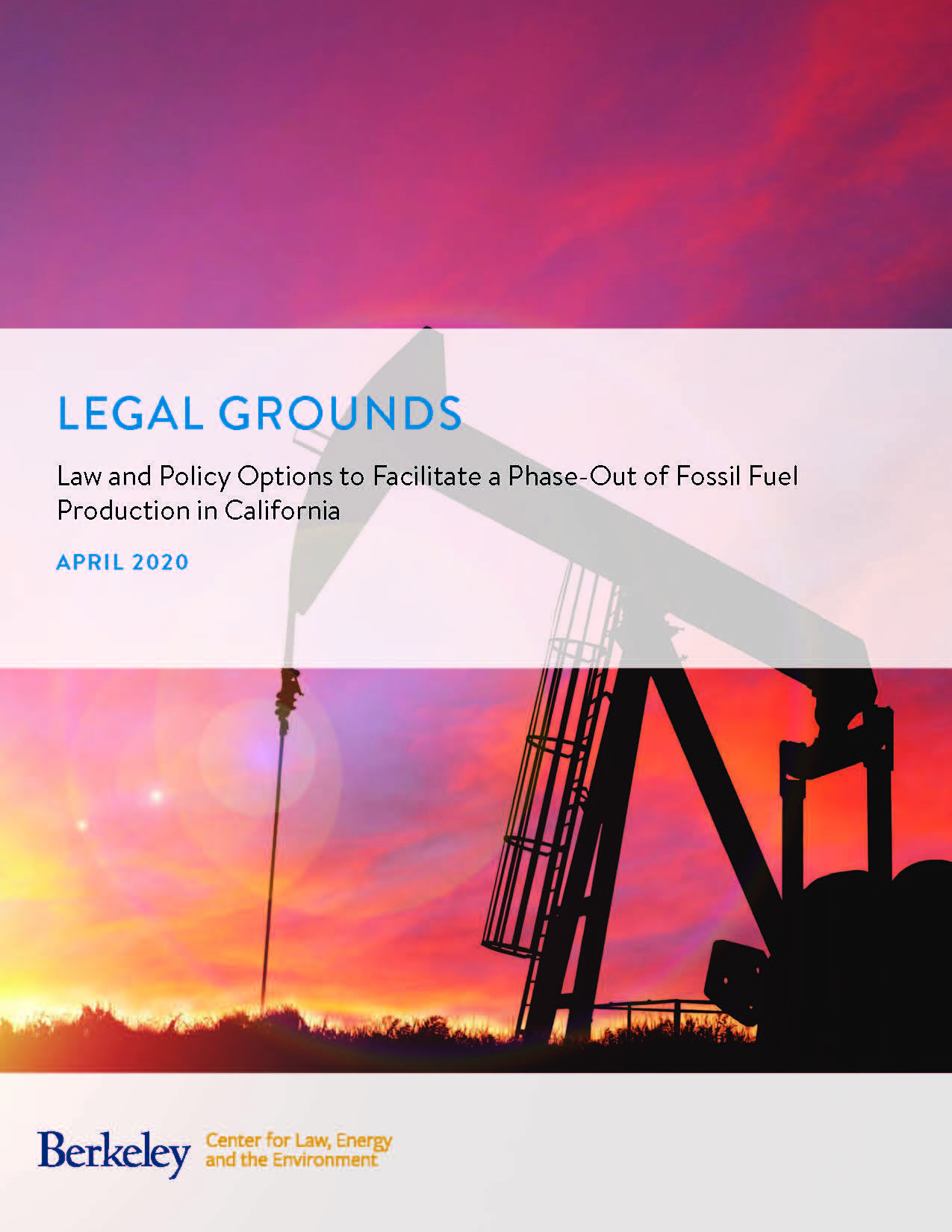California is a global pioneer when it comes to addressing climate change. The state is at the forefront of efforts to decarbonize its advanced economy in all sectors. Our program has worked closely with state and local leaders to assess these programs and recommend promising solutions. These efforts include a collaborative effort with the UC Berkeley Labor Center and Next 10 to assess the economic impacts of California’s climate policies in key geographic areas in the state, an assessment of priority policy recommendations for Governor Jerry Brown’s final term, and a California Climate Policy Dashboard that details the suite of California’s approach to climate change policy.
November 2023
Getting to Implementation: The Status of Local Climate Action in California
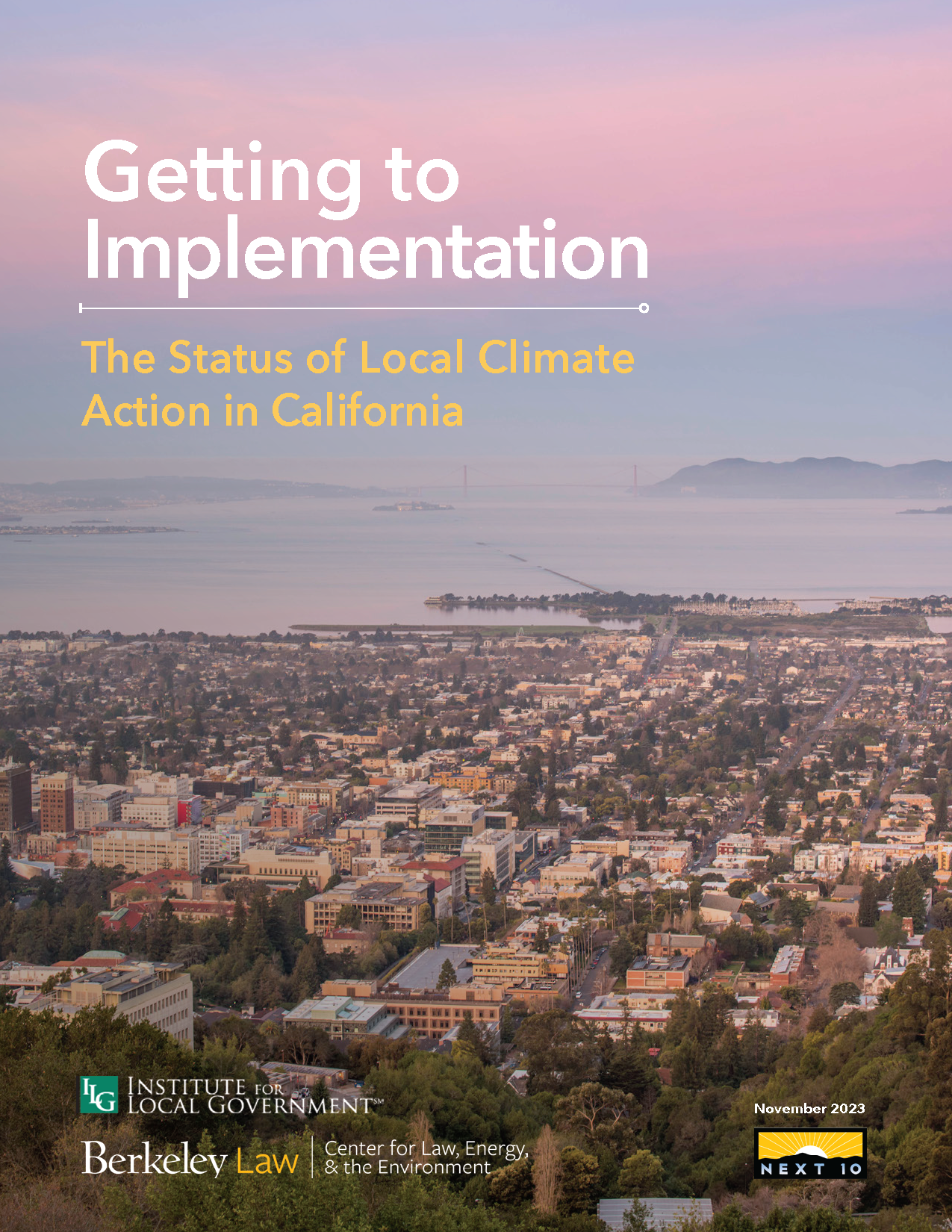 California’s local governments, which include cities, counties, and special districts, play a pivotal role in shaping the State’s transition to a decarbonized economy. However, jurisdictions across the state have varying levels of success in implementing climate policies and programs. CLEE’s new report, Getting to Implementation: The Status of Local Climate Action in California, summarizes the results of a statewide survey on local governments’ efforts to address climate change, conducted in partnership with the Institute for Local Government(opens in a new tab) (ILG).
California’s local governments, which include cities, counties, and special districts, play a pivotal role in shaping the State’s transition to a decarbonized economy. However, jurisdictions across the state have varying levels of success in implementing climate policies and programs. CLEE’s new report, Getting to Implementation: The Status of Local Climate Action in California, summarizes the results of a statewide survey on local governments’ efforts to address climate change, conducted in partnership with the Institute for Local Government(opens in a new tab) (ILG).
The California Local Government Climate Activity Survey, which was open from April to May 2023, gathered information on existing efforts to address climate change, opportunities for strategic climate policy and planning, and barriers to the timely implementation of climate solutions. The survey was designed to help assess the current status of climate action planning efforts and policy implementation, identify opportunities and barriers to move from planning to implementation, and increase understanding of resource constraints, barriers, and opportunities to advance action across a range of policy areas.
The report authors want to thank Next 10 for their support and partnership on this project.
March 2021
Priorities for Sonoma County’s Wildfire Settlement Vegetation Management Funds
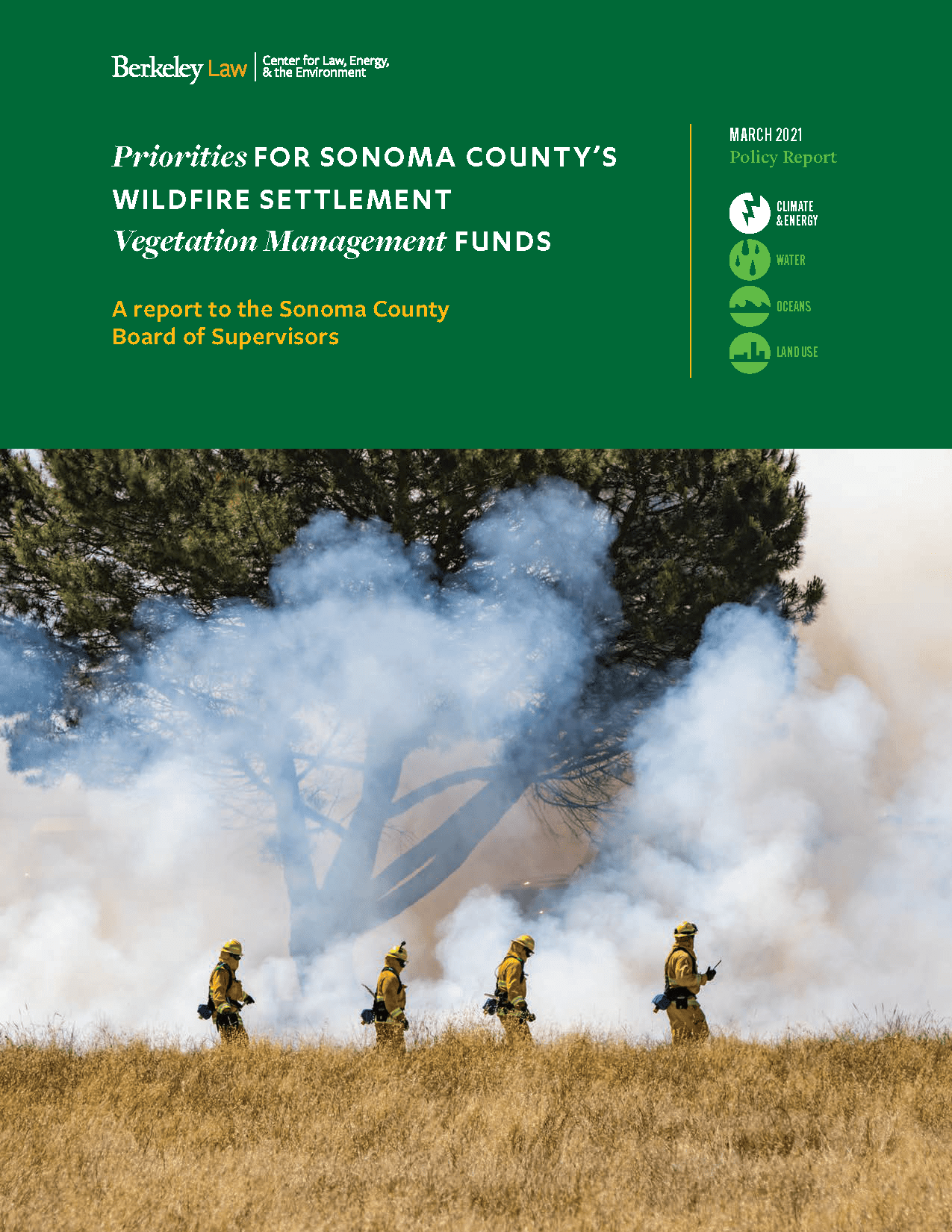 In 2017, the Sonoma Complex Fires burned hundreds of thousands of acres in the county, destroyed over 5,000 structures, and took two dozen lives. After reaching a legal settlement with Pacific Gas & Electric (whose equipment sparked the fires), Sonoma County allocated $25 million of the settlement funds to vegetation management in order to reduce future fire risk and protect ecosystems and agriculture.
In 2017, the Sonoma Complex Fires burned hundreds of thousands of acres in the county, destroyed over 5,000 structures, and took two dozen lives. After reaching a legal settlement with Pacific Gas & Electric (whose equipment sparked the fires), Sonoma County allocated $25 million of the settlement funds to vegetation management in order to reduce future fire risk and protect ecosystems and agriculture.The County retained CLEE to gather expert input and prepare recommendations for how to allocate these funds most efficiently and effectively. Considering the long-term and recurring nature of vegetation management, the diversity of County landscapes and ecosystems, and the scale of the need relative to the amount of funds, a range of strategies will be required to leverage the funds into long-term investments and ensure sustainable practices. CLEE convened a group of statewide experts and a group of County stakeholders to identify spending priorities. Our report, Priorities for Sonoma County’s Wildfire Settlement Vegetation Management Funds, outlines these priorities and offers specific strategies for the funds to achieve them.
California Climate Policy Dashboard
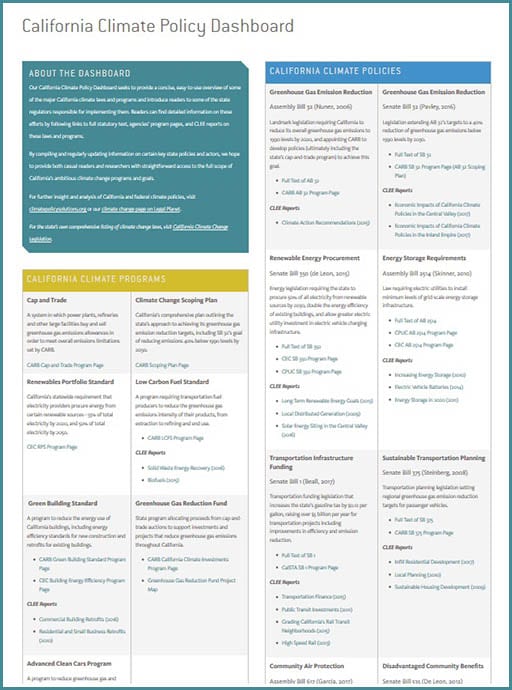
Our California Climate Policy Dashboard provides a concise, easy-to-use overview of some of the major California climate laws and programs and introduce readers to some of the state regulators responsible for implementing them. Readers can find detailed information on these efforts by following links to full statutory text, agencies’ program pages, and CLEE reports on these laws and programs. By compiling and regularly updating information on certain key state policies and actors, we hope to provide straightforward access to the full scope of California’s ambitious climate change programs and goals.
June 2020
Clean and Resilient: Policy Solutions for California’s Grid of the Future
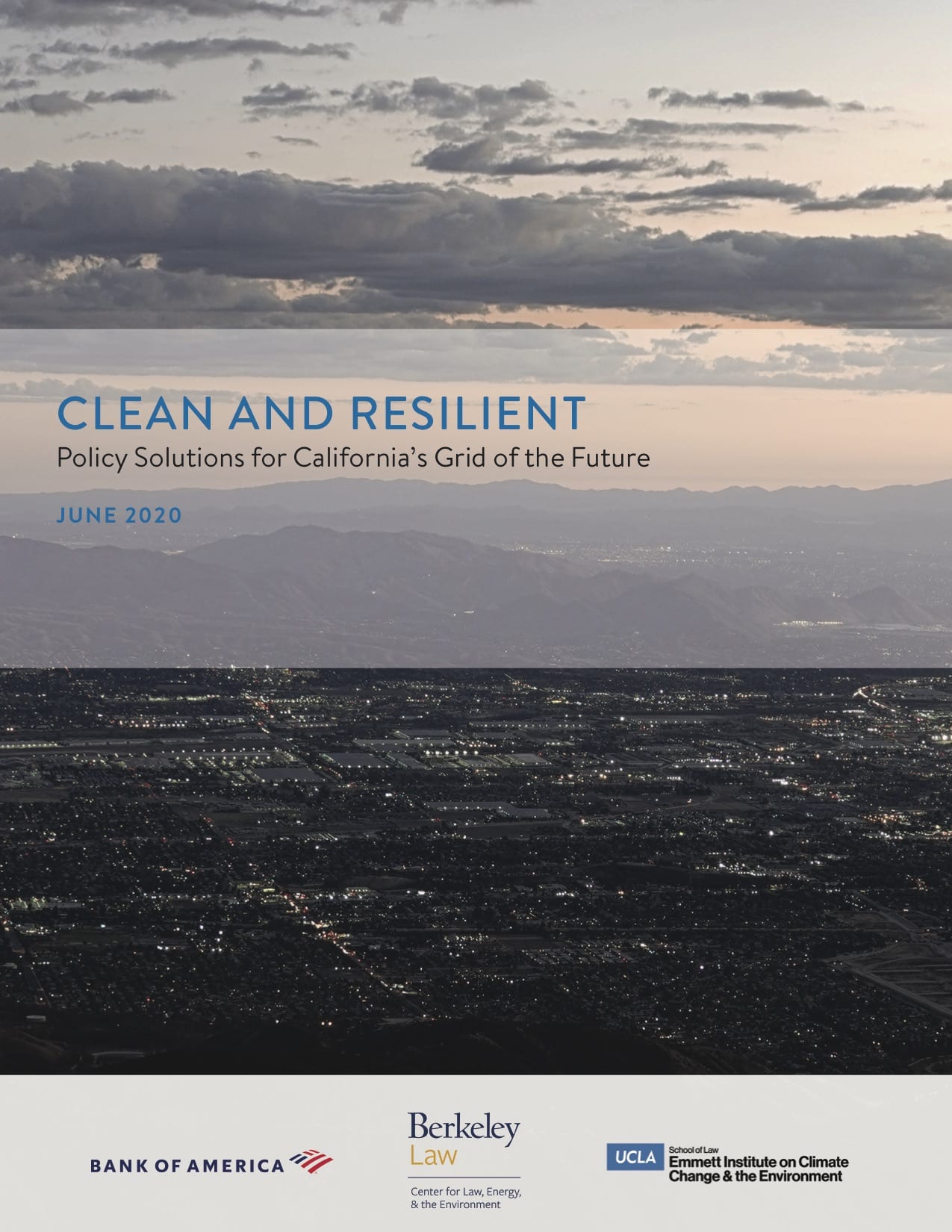 California’s electrical grid is both at the core of the state’s aggressive decarbonization goals—with targets of 60 percent renewable power by 2030 and 100 percent carbon-free electricity by 2045—and a major source of community vulnerability. Technologies like distributed renewable generation, microgrids, energy storage, building energy management, and vehicle-grid integration will be essential to promote community safety and resilience while advancing the effort to decarbonize the grid. But these investments will require significant policy and financial support to achieve these dual state goals over the coming decade.
California’s electrical grid is both at the core of the state’s aggressive decarbonization goals—with targets of 60 percent renewable power by 2030 and 100 percent carbon-free electricity by 2045—and a major source of community vulnerability. Technologies like distributed renewable generation, microgrids, energy storage, building energy management, and vehicle-grid integration will be essential to promote community safety and resilience while advancing the effort to decarbonize the grid. But these investments will require significant policy and financial support to achieve these dual state goals over the coming decade.
To address this need, CLEE and the Emmett Institute on Climate Change and the Environment at UCLA Law convened a group of California state energy regulators, local government leaders, grid experts, and clean energy advocates for a convening on California’s electrical grid of the future. Our report, Clean and Resilient, is based on this expert group’s findings.
April 2020
Legal Grounds: Law and Policy Options to Facilitate a Phase-out of Fossil Fuel Production in California
California is the seventh-largest oil producing state in the country, with a fossil fuel industry that is responsible for billions of dollars in state and local revenue and other economic activity each year. Yet continued oil and gas production contrasts with the state’s aggressive climate mitigation policies, while creating significant air and water pollution, particularly for disadvantaged communities in areas where much of the state’s drilling occurs.
As a result of these risks, many advocates and policymakers seek ways to enhance regulation of and eventually phase out oil and gas production in California. To provide legal options for policy makers to facilitate this transition, CLEE’s report Legal Grounds outlines steps California leaders could pursue on state- and privately-owned lands to achieve this reduction.
December 2019
California Climate Risk: Insurance-Based Approaches to Mitigation and Resilience
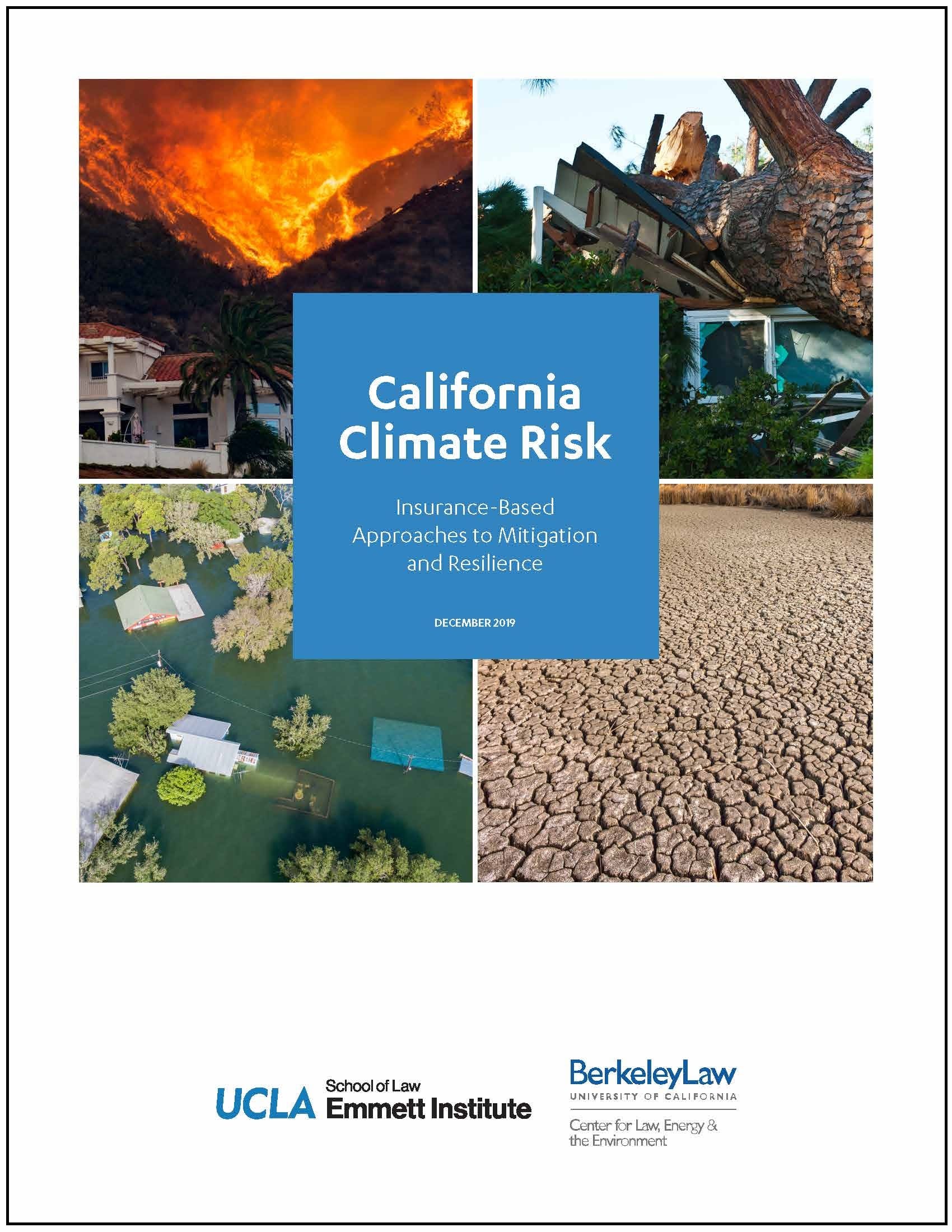 As the impacts of climate change develop and intensify throughout California, the insurance sector will play an increasingly important role in the state’s response. Policymakers, industry leaders, and local communities are all beginning to face a new paradigm of risk, resilience, and financial sustainability that insurers are uniquely positioned to help manage.
As the impacts of climate change develop and intensify throughout California, the insurance sector will play an increasingly important role in the state’s response. Policymakers, industry leaders, and local communities are all beginning to face a new paradigm of risk, resilience, and financial sustainability that insurers are uniquely positioned to help manage.
In July 2019, CLEE and UCLA Law’s Emmett Institute on Climate Change and the Environment, together with the California Department of Insurance and UN Environment’s Principles for Sustainable Insurance, convened a symposium to discuss this evolving new role for the insurance sector. Our new synthesis report, co-authored by UCLA’s Sean Hecht and CLEE’s Ted Lamm, summarizes the key findings and next steps identified at the symposium, and adds new material and analysis reflecting recent developments in the field.
November 2018
Priority Policy Solutions for California’s Next Governor
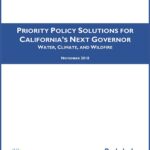 Climate change will exacerbate the droughts, floods, and wildfires that Californians already regularly experience, making them even more extreme and unpredictable. Gavin Newsom, California’s next governor, must prepare for these inevitable disasters while minimizing the greenhouse gas emissions of a society of nearly 40 million people.
Climate change will exacerbate the droughts, floods, and wildfires that Californians already regularly experience, making them even more extreme and unpredictable. Gavin Newsom, California’s next governor, must prepare for these inevitable disasters while minimizing the greenhouse gas emissions of a society of nearly 40 million people.
CLEE, together with Resources Legacy Fund (RLF), has prepared three sets of actions Governor-Elect Gavin Newsom could take immediately to address wildfire; drought, flood, and drinking water safety and affordability; and the stubbornly high carbon pollution from our transportation systems.
September 2018
Trial by Fire: Managing Climate Risks Facing Insurers in the Golden State
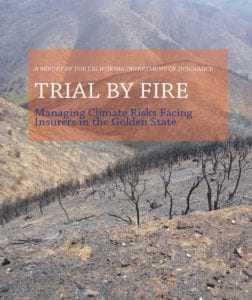 Climate change presents unprecedented risks to the insurance industry, from increased wildfires and storm events to potential litigation and economic transitions. The industry faces these dynamic challenges at the same time that insurance products are becoming more necessary but less available and affordable.
Climate change presents unprecedented risks to the insurance industry, from increased wildfires and storm events to potential litigation and economic transitions. The industry faces these dynamic challenges at the same time that insurance products are becoming more necessary but less available and affordable.
Our new report, Trial by Fire, documents the nature and extent of the risks faced by insurers and residents in California and offers a range of recommendations to protect the industry and the entire state in a changing climate.
August 2017
The Net Economic Impacts of California’s Major Climate Programs in the Inland Empire
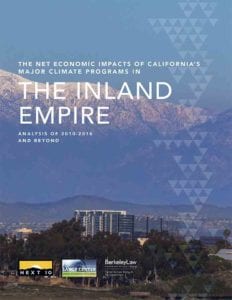
Following the state legislature’s landmark approval extending California’s cap-and-trade program through 2030 by a supermajority vote, CLEE and our research partners completed the first comprehensive, academic study of the economic effects of existing climate and clean energy policies in Southern California’s Inland Empire. The study estimated a net benefit of $9.1 billion in direct economic activity and a net gain of 41,000 jobs in the region. The study focused on San Bernardino and Riverside Counties, which both face unique economic and air-quality challenges.
January 2017
The Economic Impacts of California’s Major Climate Programs on the San Joaquin Valley
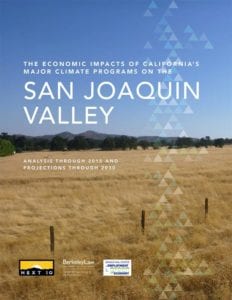
Amid concerns about the economic and employment impacts of California’s ambitious climate policies, CLEE and our research partners have conducted the first comprehensive, academic study of the costs and benefits of these policies on the San Joaquin Valley. We found a total economic benefit of $13.4 billion in the Valley including the creation of tens of thousands of jobs. We focused on the eight-county Valley region due to its bellwether status and significant economic and environmental challenges. Our study addresses compliance and investment costs as well as benefits across the region.
December 2015
Climate Actions for California: Recommendations for Governor Jerry Brown’s Final Term
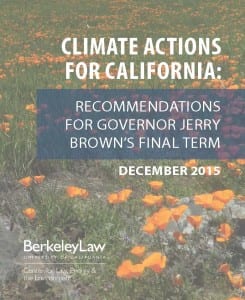 California has made landmark progress reducing carbon emissions while growing the economy, but the state’s work to reduce greenhouse gas emissions is just beginning. To reduce long-term emissions 80 percent over 1990 levels by 2050, the state will need both to build on existing programs and to address new areas that are key to decarbonizing the state’s economy, such as natural resources, water and land use. This 2015 report details steps that administration leaders, environmental and energy advocates, and other stakeholders could take to achieve additional short-term successes and create a foundation for long-term progress that endures beyond the administration.
California has made landmark progress reducing carbon emissions while growing the economy, but the state’s work to reduce greenhouse gas emissions is just beginning. To reduce long-term emissions 80 percent over 1990 levels by 2050, the state will need both to build on existing programs and to address new areas that are key to decarbonizing the state’s economy, such as natural resources, water and land use. This 2015 report details steps that administration leaders, environmental and energy advocates, and other stakeholders could take to achieve additional short-term successes and create a foundation for long-term progress that endures beyond the administration.
September 2010
California at the Crossroads: Proposition 23, AB 32, and Climate Change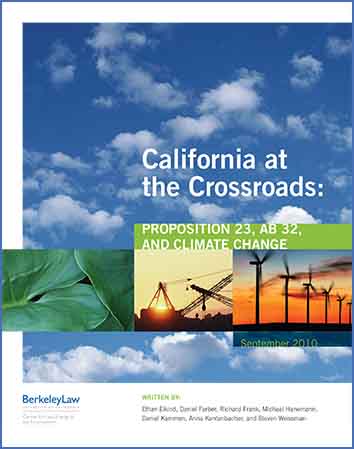
Proposition 23, an initiative that appeared on California’s November 2010 general election ballot, would have suspended the implementation and operation of California’s Global Warming Solutions Act of 2006, better known as AB 32, until state unemployment rates remained at or below 5.5 percent for four consecutive quarters. That level has been reached three times since the state began compiling these statistics in 1976. This white paper evaluated the initiative backers’ claims and sought to provide an independent, objective analysis of the legal and economic consequences of Proposition 23 and rolling back California climate change goals.
